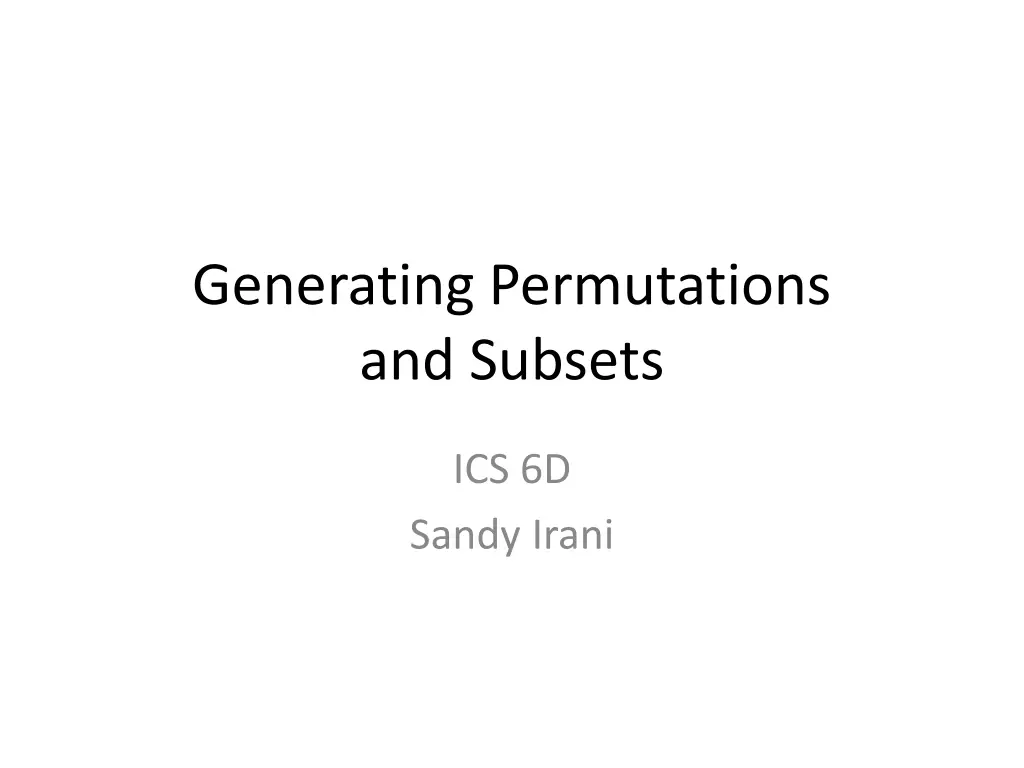
Understanding Lexicographic Order in Permutations and Subsets
Explore lexicographic order in permutations and subsets, diving into definitions, examples, and the process of generating permutations in a specific order. Understand how to arrange permutations in lexicographic order and learn the basics of generating permutations over a given set.
Download Presentation

Please find below an Image/Link to download the presentation.
The content on the website is provided AS IS for your information and personal use only. It may not be sold, licensed, or shared on other websites without obtaining consent from the author. If you encounter any issues during the download, it is possible that the publisher has removed the file from their server.
You are allowed to download the files provided on this website for personal or commercial use, subject to the condition that they are used lawfully. All files are the property of their respective owners.
The content on the website is provided AS IS for your information and personal use only. It may not be sold, licensed, or shared on other websites without obtaining consent from the author.
E N D
Presentation Transcript
Generating Permutations and Subsets ICS 6D Sandy Irani
Lexicographic Order S a set Sn is the set of all n-tuples whose entries are elements in S. If S is ordered, then we can define an ordering on the n-tuples of S called the lexicographic or dictionary order. For simplicity, we will discuss n-tuples of natural numbers.
Lexicographic Order: Example (3, 8, 3, 4, 2, 1) <? Or >? (3, 8, 3, 2, 2, 1)
Lexicographic Order: Definition (p1, p2, , pn) (q1, q2, , qn) Let k be the smallest index such that pk qk (If the n-tuples are different they have to differ somewhere). If pk< qk, then (p1, p2, , pn) < (q1, q2, , qn) If pk> qk, then (p1, p2, , pn) > (q1, q2, , qn)
Lexicographic Order: Examples (2, 5, 100, 2, 4) (2, 5, 100, 2, 5) (1, 100, 1000) (2, 1, 0) (5, 4, 5, 6, 7) (4, 5, 8, 10, 11)
Generating all Permutations A permutation of {1, 2, , n} is an n-tuple in which each number in {1, 2, , n} appears exactly once. Example: (5, 2, 1, 6, 7, 4, 3) is a permutation of {1, 2, 3, 4, 5, 6, 7} How to generate all permutations over the set {1, 2, , n}? Will output the permutations in lexicographic order
Lexicographic Order of Permutations Here are all the permutations of {1, 2, 3, 4} in lexicographic order: (1, 2, 3, 4) (1, 2, 4, 3) (1, 3, 2, 4) (1, 3, 4, 2) (1, 4, 2, 3) (1, 4, 3, 2) (2, 1, 3, 4) (2, 1, 4, 3) (2, 3, 1, 4) (2, 3, 4, 1) (2, 4, 1, 3) (2, 4, 3, 1) (3, 1, 2, 4) (3, 1, 4, 2) (3, 2, 1, 4) (3, 2, 4, 1) (3, 4, 1, 2) (3, 4, 2, 1) (4, 1, 2, 3) (4, 1, 3, 2) (4, 2, 1, 3) (4, 2, 3, 1) (4, 3, 1, 2) (4, 3, 2, 1)
Lexicographic Order of Permutations The smallest permutation of {1, 2,.., n} is (1, 2, 3, , n) The largest permutation of {1, 2,.., n} is (n, n-1, , 2, 1)
Lexicographic Order of Permutations GeneratePermutationsInLexOrder(n) Initialize P = (1, 2, , n) Output P While P (n, n-1,.., 2, 1) P = GetNext(P) Output P
Get Next Permutation (8, 2, 5, 3, 7, 6, 4, 1)
Get Next Permutation GetNext (p1, p2, , pn) Find the largest k such that pk< pk+1 Find the largest j such that j > k and pj> pk Swap pjand pk Reverse the order of pk+1, ,pn
Get Next Permutation Examples: (2, 1, 4, 3, 5, 6) (5, 2, 6, 4, 3, 1)
Get Next Permutation Examples: (4, 5, 6, 3, 2, 1) (6, 5, 4, 3, 2, 1)
r-Subsets The order in which the elements of a subset are listed does not matter, so {5, 8, 2} = {2, 5, 8} In order to avoid over-counting subsets, we will always list their elements in increasing order: Examples: {2, 5, 8} {1, 4, 5, 16}
Lexicographic Order of r-Subsets First order the elements of the subset in increasing order The apply lexicographic ordering as if they were ordered subsets: {4, 1, 7, 3} {5, 4, 3, 2}
Lexicographic Order of r-Subsets What s the smallest 5-subset of {1, 2, 3, 4, 5, 6, 7, 8, 9, 10, 11, 12, 13}? What s the largest 5-subset of {1, 2, 3, 4, 5, 6, 7, 8, 9, 10, 11, 12, 13}?
Lexicographic Order of r-subsets Here are all the 3-subsets of {1, 2, 3, 4, 5} listed in lexicographic order: {1, 2, 3} {1, 2, 4} {1, 2, 5} {1, 3, 4} {1, 3, 5} {1, 4, 5} {2, 3, 4} {2, 3, 5} {2, 4, 5} {3, 4, 5}
Lexicographic Order of r-Subsets Generate-r-SubsetsInLexOrder(r, n) Initialize P = (1, 2, , r) Output P While P (n-r+1, n-r+2,.., n-1, n) P = GetNext(P) Output P
Get Next r-Subset {3, 4, 7, 8, 9} from set {1, 2, 3, 4, 5, 6, 7, 8, 9}
Get Next r-Subset GetNext {p1, p2, , pr} Find the largest k such that pk< n-r+k pk= pk+ 1 For j = k+1, ,r pj= pj-1 + 1
Get Next r-Subset Examples: (r = 5, n = 9) {1, 2, 4, 5, 6} {2, 4, 6, 7, 9}
Get Next r-Subset Examples: (r = 5, n = 9) {2, 3, 5, 8, 9} {4, 6, 7, 8, 9}
